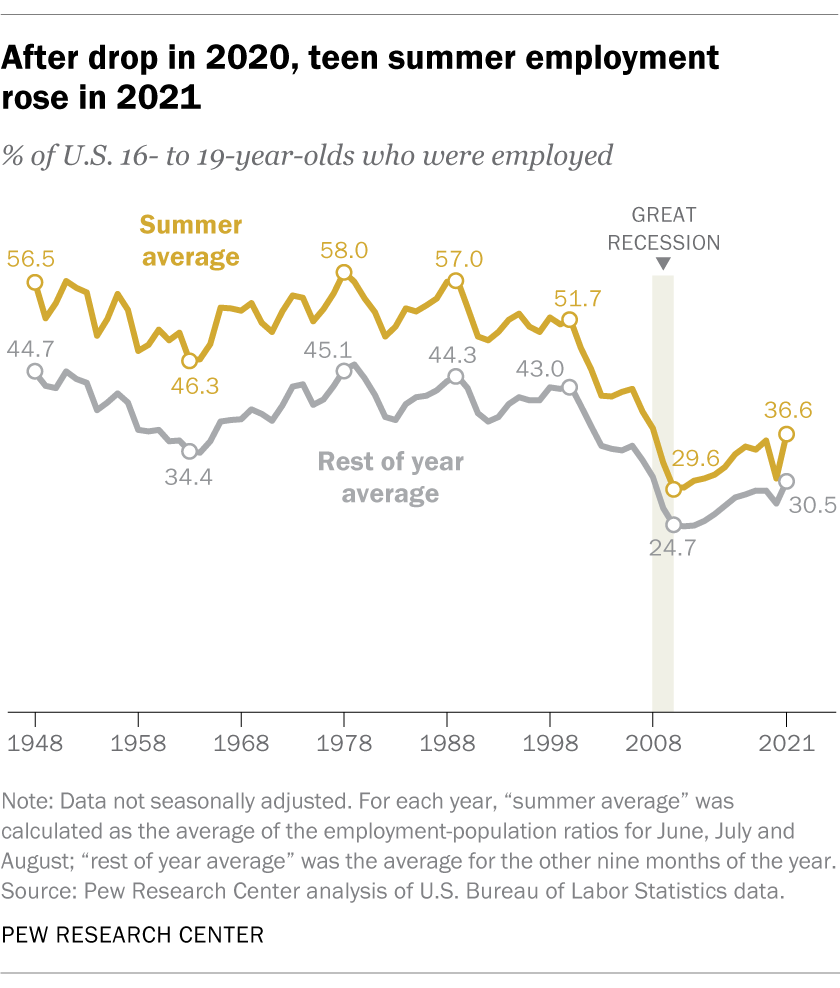Why your company should hire high school-aged interns
Hiring more high school-aged interns today could have big impacts on tomorrow's labor force.
For many years, a disconnect between education and the workforce has created vast misalignment and missed opportunities for young talent. The Harvard Business Review notes that the U.S. education system is not equipping students with the skills necessary to pursue careers that will allow them to become financially stable. To build a seamless talent pipeline, we need business leaders to shift the narrative by providing young talent, including high schoolers, opportunities to explore careers through internships and gain employable skills in the process.
--
While nowhere near the peaks reached during the 1970s and 80s, teenage employment rates have been rising nationally for about a decade. About 37% of 16- to 19-year-olds had a summer job in 2021, up 7 percentage points from 2010. Rates of teenage employment during the non-summer months have been climbing too: about 31% of teenagers held a job during non-summer months in 2021, up from 25% in 2010.
Those trends aren’t visible across the Baton Rouge Metro. In 2010, about 29% of teenagers in Baton Rouge were employed during the year (including summer and non-summer months). Over the last decade, that rate has fluctuated only slightly. Today, about 30% of teenagers in Baton Rouge are employed.
Employment provides a laundry list of benefits for the teenage worker. Through employment, teenagers have the opportunity to improve soft skills like communication, something that is consistently cited as the most-desired skill by employers in regional job postings. Working a job while in high school also creates a source of income for employed teenagers, giving them opportunities to practice budgeting or spend their hard-earned cash.
Teenage employment also has benefits for the community. Last year we discussed how 79% of young adults who lived in Baton Rouge at age 16 still lived here at age 26. While this tracks with the general notion that the majority of people stay in the same place from one year to the next, 79% was much higher than our peer metros like Houston (77%), Greenville, SC (74%) and New Orleans (70%). By offering internship opportunities to high school students, we’d be upskilling our own future workforce, as so many of these students will still be in the metro area as young adults.
There’s also a correlation at the metro level between historical teenage employment and current young adult employment. Using American Community Survey (ACS) data on employment rates for 16- to 19-year-olds from 2014 and comparing those data to 2021 young adult employment rates for the 100 largest metros in the country, we find a strong correlation between rates of teenage employment in 2014 and labor force participation rates for young adults in 2021. The chart below includes 2021 data for both 20- to 24-year-olds and 25- to 29-year-olds; a 16-year-old in 2014 would have been 23 in 2021, and a 19-year-old would have been 26, so the two age groupings capture the progression of both younger and older teenage workers since 2014.
In 2014, 27% of teenagers in the Baton Rouge Metro (orange dots) were employed, lower than the average for all metros in the study (28%). Seven years later, 72% of 20- to 24-year-olds were participating in the labor force, about 4 percentage points below the study’s average. About 83% of 25- to 29-year-olds in the Baton Rouge Metro were in the labor force in 2021, also below the average (84%) of the studied metros.
There’s an even stronger correlation between teenage employment in 2014 and the share of the working young adult population in 2021, coined here as the employment/population ratio. While labor force participation rates include both people working and people looking for work, the employment/population ratio only looks at those who are working and does not include people who are looking for work. This means that, at the metro-level, teenage employment has an even stronger relationship with the share of young adults that are successful at becoming employed. This has important long-term implications for a metro that has struggled to bring folks back into the labor force to fill a historically large number of available jobs.
In 2021 about 64% of 20- to 24-year-olds in Baton Rouge (blue dots) were working, more than 3 percentage points below the average for all metros in the study. About 77% of 25- to 29-year-olds were working, also more than a full percentage point below the study’s average. Taken together, these correlations suggest that improving our rates of teenage employment through part-time jobs and internships could boost the number of employed young adults over the next 5 to 10 years.
There are important caveats. Employers across the Capital Region are struggling to fill open jobs today, and while teenagers can serve important functions in entry-level service positions and internship-style corporate roles, 16- to 19-year-olds won’t have the skills needed to succeed in more complex roles. Teenagers will also require more training and more supervision than their older colleagues. On the flip side, hiring teenagers to work part-time jobs or internships can provide valuable management opportunities to younger, full-time employees who otherwise wouldn’t have an opportunity to hone their management skills. In terms of cost, teenagers can often be hired at lower wages, working internships and part-time jobs at rates below those offered to workers with a high school or college degree.
These pros and cons focus on the short-term, though, and they don’t capture the important long-term implications. We know that, historically, four in five Baton Rouge 16-year-olds still live here at age 26. And we know there’s a strong correlation between past teenage employment rates and current young adult employment rates for the country’s largest metros. For Baton Rouge businesses that plan to have a Capital Region presence over the next decade, the best way to ensure they have a reliable workforce for years to come is to provide opportunities to today’s teenagers through part-time jobs and internships. Without opportunities, today’s teenagers may be less engaged in the Capital Region workforce as young adults.
--
Businesses interested in hosting a high school intern are encouraged to learn more about the Talent Action Collaborative’s internship initiative at brac.org/tac. The initiative has a goal to place 1,000 East Baton Rouge Parish School System high school students into internships at businesses in high-demand industries. If your business is ready to host a high school-aged intern this summer or upcoming school year, you can register here.








